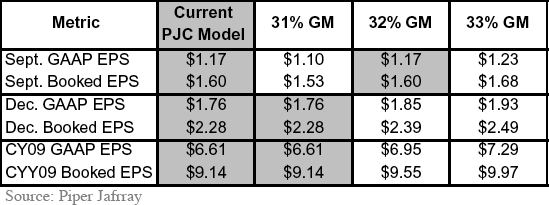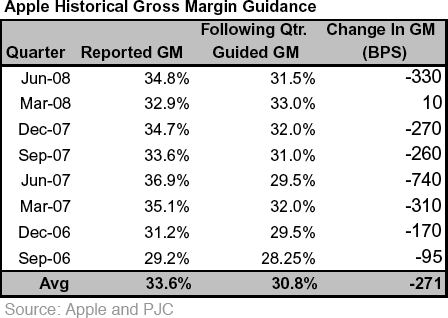Margin impact of Apple product transitions overestimated
The Cupertino-based company during a conference call in July guided its September quarter gross margin down 330 basis points sequentially to 31.5 percent, citing expected impact from a mysterious product transition, a full quarter of back-to-school promo sales, and a one time true-up with a manufacturing partner.
The lower-than-expected guidance was of immediate concern to investors, but as analyst Gene Munster points out in a new report Tuesday, the quarter has since ended and none of the company's actions seem to warrant such a drop-off in margins.
"Apple cited new, lower-margin products, but the only new products announced in the September quarter were new iPod nanos with higher capacities at the same prices and a 23 percent price cut on the iPod touch," he wrote. "Considering the decline in NAND Flash pricing has been at least in-line with typical seasonality, it is unlikely that these changes will result in a greater than average sequential GM decline."
In other words, Munster believes the falling cost of NAND flash memory — historically the most expensive component used in iPods — will offset any reductions in the retail price of the players instated by Apple.
As for the back-to-school promo, the analyst believes that Wall Street already has a concrete understanding of its effects, which have been communicated well over the years. That said, he believes the impact of this year's promo is being overestimated in terms of its hit on the company's bottom line, yet underestimated in terms of how many additional Macs it helped sell.
Therefore, Munster said he remains confident in his September quarter gross margin estimate of 32 percent, arguing that the conservative margin guidance offered by Apple management was simply a base case used to rein in Wall Street's ballooning expectations, and not an indication of how it expected the company to perform.
Apple also used the same conference call in July to guide down its margins for the entire 2009 fiscal year, which similarly served to rattle investors. The company, however, offered no reason the change other than saying upcoming product transitions will likely involve lower prices on existing products.
To Munster, this is clearly a signal that Apple will introduce new notebooks with at least one model coming in at sub-$1000 recession pricing. While such a move would clearly impact margins, it wouldn't be enough to drive them down to the 30 percent level, he said. Therefore, should the company guide margins for the December quarter down to 30 percent, it would again be seen as a conservative play. On the other hand, an absence of lower-priced Macs could prove detrimental to the company's shares.
"Importantly, we believe investors would see the lack of redesigned, lower-priced Macs as a more significant negative than they would a 30 percent GM guide in the December quarter," he argued. "Net-net, if Apple issues December GM guidance of 30 percent based on lower-priced Macs, the new Macs would be a positive for the stock."
Munster maintained his Buy rating on shares of Apple and held strong to his $250 12-month price target. He included with his report two charts (above), one of which estimates the company's per-share earnings sensitivity to various gross margin scenarios, while the other shows how the company has routinely guided down its margins for the past eight quarters only to smash those estimates when it reports results three months later.
 Katie Marsal
Katie Marsal












 Mike Wuerthele
Mike Wuerthele

 Malcolm Owen
Malcolm Owen
 Chip Loder
Chip Loder

 William Gallagher
William Gallagher
 Christine McKee
Christine McKee
 Michael Stroup
Michael Stroup







